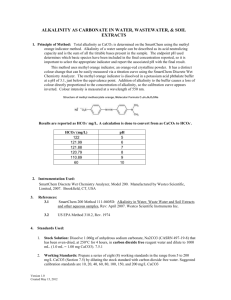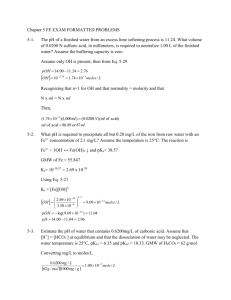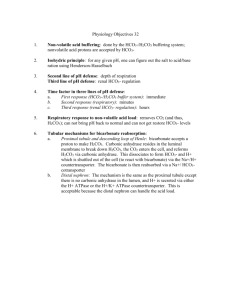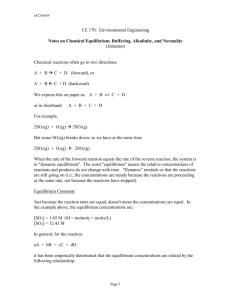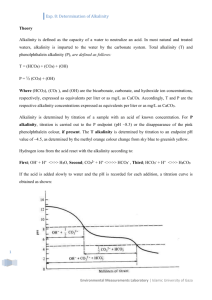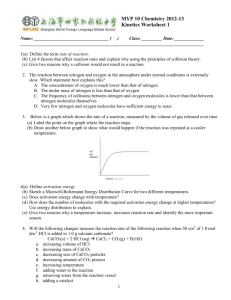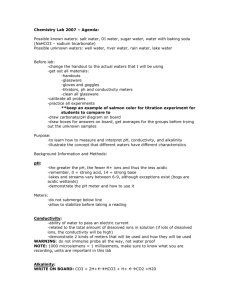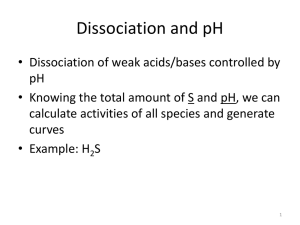Lecture_03_ChemO
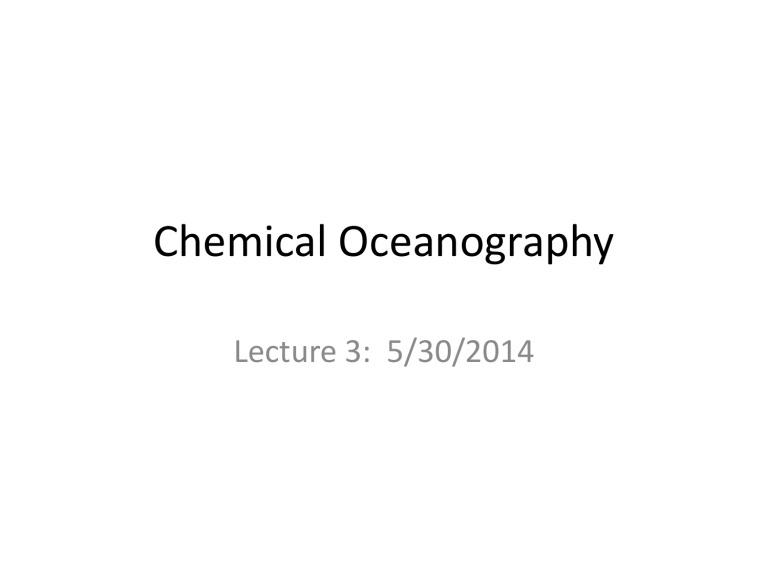
Chemical Oceanography
Lecture 3: 5/30/2014
Salinity
• Definition: weight of inorganic salts in one kg of seawater
• There are many ions and salts in seawater, but they are never the dominant mass
Inputs Outputs
Weathering: the physical & chemical processes that break down rock
A simplified biogeochemical cycle
Steady State and Equilibrium
• Draw on board
Acidity
• pH = -log[H + ]
– Dissociated water molecule
H
2
O = H + + OH -
In 1L of water (55.6 moles) 10 -7 moles dissociated; therefore, 10 -7 moles/L of both H + and OH (i.e. pH =
7, pOH = 7)
• pH < 7 = acidic, pH > 7 alkaline
Seawater Buffering, Alkalinity
• Alkalinity = measure of the amount of ions present that can react with, or neutralize, H +
– Higher alkalinity of a solution more difficult to produce a pH change by adding acid
– Alkalinity measures acid buffering capacity
• Simple measure of Alkalinity (A)
A = [HCO
3
] + 2[CO
3
] + [OH] - [H + ]
Assumes bicarbonate, carbonate, hydroxyl ions dominate seawater alkalinity
Seawater Buffering, Alkalinity
• More substances can react with [H + ]
From Pilson 1998
Seawater Carbonate Buffer System
Two important carbon reactions pertain to primary production:
CO
Ca
2
+2
+ H
2
O
CH
+ HCO
3
-
2
O + O
CaCO
3
2
+ H + (
( consumes produces acid) acid)
CO
2
(g)
H
2
CO
C org
3
(aq)
HCO
3
-
CO
3
-2
CaCO
3
‘export’
Air
Sea – photic zone
Sea – aphotic zone
Ecology influences the net effect of biology on the air-sea transfer!
H
2
CO
3
3 Equations
– a diprotic weak acid but, 5 unknowns!
Thermodynamic Constants
K
H
K
1
K
2
= pCO
2
/{H
2
CO
3
}
= {H
= {H
+
+
}{HCO
}{CO
3
3
-2
}/{H
2
CO
}/{HCO
3
}
3
}
‘Apparent’ Constants
K
K
1
2
’ = K
= {H
10 -6.0
(@25 o C, I=0.7)
’ = K
1
2
+
H2CO3
}[HCO
HCO3-
3
-2
3
-
/
HCO3-
]/[H
2
CO
3
]
/
CO3-2
= {H + }[CO ]/[HCO
10 -9.1
(@25 o C, I=0.7)
3
]
How can system be defined uniquely?
• pCO2 (open system)
• pH (≡ -log a
H+
)
•
S
CO2 (mass balance)
• Alkalinity (acid-neutralizing capacity)
S
CO
2 i.e. DIC mass balance constraint
= [H
2
CO
~1%
3
] + [HCO
~90%
3
] + [CO
~9%
3
-2 ]
Respiration
CH
2
O + O
2
CO
2
+ H
2
O
Dissolution
CaCO
3
+ H +
Ca +2 + HCO
3
-
S
CO2
Total Dissolved Inorganic Carbon DIC, i.e.
S
CO2 ( m mol/kg)
Total Alkalinity ( m mol/kg)
Discospaera sp., another coccolithophorid
Emiliania huxleyi, a coccolithorophorid planktonic foraminifera bryozoa stalks sponge spicules
These organisms all make skeletal material from
calcium carbonate – calcite in some cases, aragonite in others
Both CaCO
3 pteropods
Centric diatoms – an alga
Both make a skeleton based on the element
Si – ‘biogenic silica’ or SiO
2
Radiolarian – a protozoan
Solubility of Calcite versus Aragonite
CaCO
3
(s)
Ca +2 (aq) + CO
3
-2 (aq)
K sp
* = [Ca +2 ] saturated
+ [CO
3
-2 ] saturated
K sp
* calcite (e.g., foraminifera, coccolithophorids): 3.3 x 10 -9 aragonite (e.g., coral, pteropods): 4.6 x 10 -9
Biogenic Silica (e.g. diatoms, radiolarian): 2.0 x 10 -3
Q: What is more soluble – CaCO
3 or SiO
2
?
Q: Which form of calcium carbonate is more soluble?
Dissolution of biogenic particles
• Solubility also is a function of temperature and pressure
• In the deep ocean, CaCO becomes very soluble
3
– Carbonate Compensation
Depth (CCD)
• Below CCD calcium carbonate is undersaturated (like SiO
2
)
– Decrease in pH also can increase calcium carbonate solubility
– CCD is a dynamic depth (NOT fixed)
Nutrients
• In oceanography, “nutrient” refers to important and commonly measured element needed for growth of plants
• Includes the major nutrients (i.e. macronutrients):
– Phosphorus
– Nitrogen
– Silicon
Phosphorus Cycle: global
Ruttenberg, 2001 (Encyclopedia of Ocean Sciences)
Phosphorus
• Forms of occurrence in seawater
– Inorganic phosphate (i.e. orthophosphate)
• No major redox state differences
• Nearly all dissolved phosphorus present in deep sea
– Organic phosphorus
• Phospho- … -lipids, -proteins, -carbohydrates
• Nucleic acids & nucleotides
• Phosphonic acid derivatives
– Polyphosphates
• Wide variety of straight-chain, branched and cyclic polymeric forms
• Sorption affects bioavailability
– Fe oxy-hydroxides, Carbonate-mineral sorption
• Redox sensitivity
– Low Dissolved oxygen induces phosphate release from sediments
(VERY IMPORTANT IN Gulf of Mexico and adjacent estuaries)
Distribution of Dissolved organic phosphorus
(DOP) and Soluble Reactive Phosphorus (SRP)
Nitrogen in the marine environment
Gruber (Ch 1) in Nitrogen in the Marine Environment 2 nd Ed (2008)
Nitrogen acquisition
• Chemical forms of nitrogen and their major characteristics
Oxidized Reduced
Chemical
Form
Nitrate
(NO
3
)
Nitrite
(NO
2
)
+3
Nitrous oxide
(N
2
O)
Nitrogen gas
(N
2
)
Ammonia
(NH
4
+ )
Amines
(-NH
2
)
+2 0 -3 -3 Oxidation
State
Used by plants
+5
Yes Yes No Yes Yes Yes
Major Chemical forms/transformations
Gruber (Ch 1) in Nitrogen in the Marine Environment 2 nd Ed (2008)
Gruber (Ch 1) in Nitrogen in the Marine Environment 2 nd Ed (2008)
Global Mean Profiles
Gruber (Ch 1) in Nitrogen in the Marine Environment 2 nd Ed (2008)
Behold … the world’s most awesome element
Silicon
• Second most abundant element in earth’s crust
– 25.5% of crust by weight (Oxygen is 49%)
– Si-O chemical bond one of most abundant
• In seawater Si is relatively scarce ~0.0003 atom%
• In diatoms (a phytoplankton group beloved by your instructor) = 5.0 atom %
• Some vertebrates = 0.001 atom%
Current view of the marine Si cycle
Tréguer and De La Rocha
Annu. Rev. Mar. Sci. 2013
NOTE:
• No major gas phase
• No major organic Si pool
• UNITS: Tmols Si year -1
Dissolved silicate
• At seawater pH
– >97% Si(OH)
4
(orthosilicic acid)
• Dominant form transported by diatom (Del Amo and
Brzezinski 1999, Journal of Phycology)
• pH 8.7-8.9
– 14-23% ionic (Si(OH)
3
-
• May be transported across the membrane but typically much lower rates (Reidel et al. 1984 Journal of
Phycology)
Ocean Chemical Tracers
• Tracer conservation equations establish the relationship between the time rate of change of tracer concentration at a given point and the processes that can change that concentration (Sarmiento and Gruber
2006)
– Processes include:
• Physical transport (advection, mixing)
• Sources and sinks (biological and chemical transformation)
• Examples: chemical ocean tracers
– AOU = apparent oxygen utilization
– Chlorofluorocarbons (CFC)
– Carbon 14
AOU
• Apparent Oxygen Utilization
– AOU = [O
2
] saturated
– [O
2
] measured
• Difference between measured oxygen and what equilibrium saturation (as a function of the physical/chemical characteristics)
– From biological activity
– Oxygen increased by primary production
– Oxygen used by respiration
Apparent Oxygen Utilization
AOU =
[O
2
] saturated
– [O
2
] measured
Which locations have the highest AOU at depth? Lowest? Why?
AOU and Preformed Nutrients
• Preformed nutrients: those initially present at the time of downwelling
= total nutrient – regenerated nutrient
- Calculated using AOU
• Characteristic of waters originating from different regions
– Hence use as tracer
‘Preformed’
Nutrient
Phosphate
Preformed P (top) &
Preformed N (bottom)
From Sarmiento &
Gruber 2006
From Broecker et al. 1985
CFC
• Manmade compounds (where are highest values?)
• High radiative forcing (relative to CO
2
)
• 12,400x higher for CFC-11
• 15,800x higher for CFC-12
• Useful as ocean tracers (i.e. only manmade source is from atmosphere)
Tree Ring Records
Natural vs Anthropogenic 14 C
Production
Industrial Revolution
Burning 14 C-dead Coal!
“Suess Effect”
-
Coral Records
Nuclear Weapons Testing!
Test Ban Treaty – 1963!
14 C now decreasing
• surface waters (-50 ‰) contain more 14 C than deep waters
• deep waters in the Atlantic contain more 14 C than those in the Pacific while those in the Indian Ocean and Antarctic have intermediate values.
